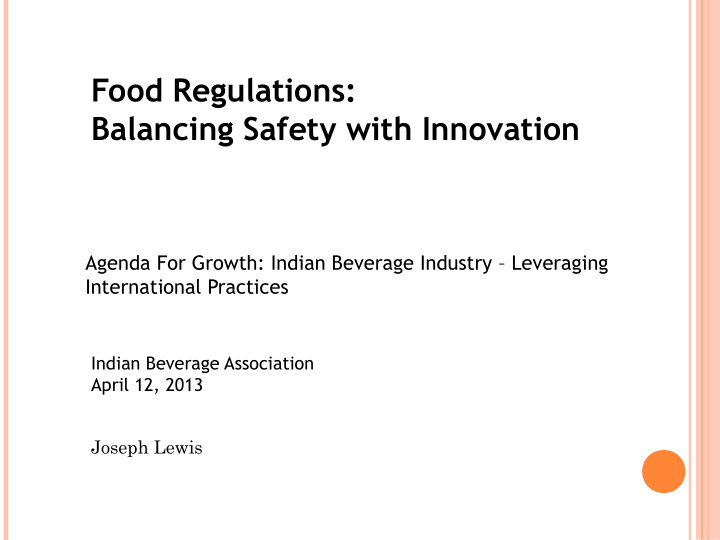



Food Regulations: Balancing Safety with Innovation Agenda For Growth: Indian Beverage Industry – Leveraging International Practices Indian Beverage Association April 12, 2013 Joseph Lewis
India . . A leading producer No Commodity Production/Yr (m MT) 1 Milk 105 2 Tea 0.9 2 Rice 104 2 Fruits & Vegetables 150 3 Food grains 230 3 Fish 7 ABUNDANTLY BLESSED . . . No. 1 Growth Sector – 7.5% 52% cultivable land (11% world average) annual 15 major climates 300 billion US$ (2013). 46 of 60 soil types exist http://www.indiainbusiness.nic.in/industry-infrastructure/industrial-sectors/food-process.htm
And yet Innovation is a Challenge
Technological Challenge Tomato Soup Permission to add: o SODIUM BI CARBONATE (INS 500ii) o Cooking Soda ACIDITY REGULATOR JECFA: ADI ‘NOT LIMITED’ (1965) Codex Table 3: in accordance with GMP
2. Standardization: Twofold Effect Creates a mindset of exclusive Tomato Chutney appropriation . Illegalizes an honestly labelled product Imposes its specifications Stan 160-1987: Mango Chutney (Codex) Std 2.3.42: Mango Chutney TSS 50% Std 2.3.41 ‘ Fruit & Vegetable Chutney’ Fruit Chutney TSS 50% Vegetable Chutney TSS 25% Hot & Sour (Spicy) TSS 25%
PROPRIETARY FOODS. . . It is not a ‘category of foods’ sharing certain attributes e.g. Food Supplements Foods for Special Dietary Uses It represents an enabling ‘provision’ in food law to develop and market food products in an unencumbered manner Within the applicable regulations.
If Product Development is about . . . Access to markets speed to Market Then we need . . . ENABLING REGULATIONS
Food safety & standards act 2006 FSSA – AN ENABLING FOOD LAW COMPATIBLE WITH INTERNATIONAL ACTS HARMONIZE WITH FSSA RE- CALIBRATE FOCUS
INDUSTRY EXPECTATIONS KEY FINDINGS OF THE FICCI 2010 SURVEY % Harmonization with International Regulations (Food 92 Additives, Food Category System, Labeling) Appreciates consolidation of multiple Food Laws 86 Lack of transparency (PFA) 76 Standards are not risk based (PFA) 66 Inconsistent application of regulations by Enforcement 67 Agencies (PFA) * About 1/3rd Industry unaware of FSSA 2006
FSSA - Mandate The Act requires while framing regulations to: Determine food standards on the basis of risk analysis [18(2)(b)] Undertake risk assessment in an independent, objective and transparent manner [18(2)(c)] Carry out risk management which shall include taking into account the results of risk assessment . . .[18(1)(b)] It is harmonized . . .
What is ‘ harmonization’ ?
Harmonization: Shift from ‘ text’ to ‘context ADI not specified : Lower Risk 1. R I S K A N A L S I S Added in accordance with ‘ GMP’ o 170 food additives o 2. ADI specified: Higher Risk o Max levels of use specified o Food Specified 3. Food Category System o ‘hierarchical’ allotment
Harmonization – Text or context? EU Permitted in all foodstuffs, (listed in Annex 1) R I S K A N A L S I S Following the ‘ quantum sati's ’ principle, Australia – Schedule 2 additives may be added – In accordance with GMP US FDA – Prior Sanctioned – Additives in use prior to 1958 – GRAS – Self Affirmation
PRODUCT APPROVAL
Risk Based Separation: Regulate Accordingly
Unpack Section 22 Aberration: Schedule 1 (VIII) Notify each food category separately Retain Proprietary Foods – a provision
Freedom to innovate Innovate with ‘ Predictability’ Science based ( Evidence ) Transparent Process
WE ALL WANT SCIENCE BASED . . . “ Washington is a town where people say they are for science-based decision making until the overwhelming scientific consensus leads to a politically inconvenient conclusion.” Sherwood Boehlert: Chairman: House Science Committee, US
THANK YOU
Recommend
More recommend